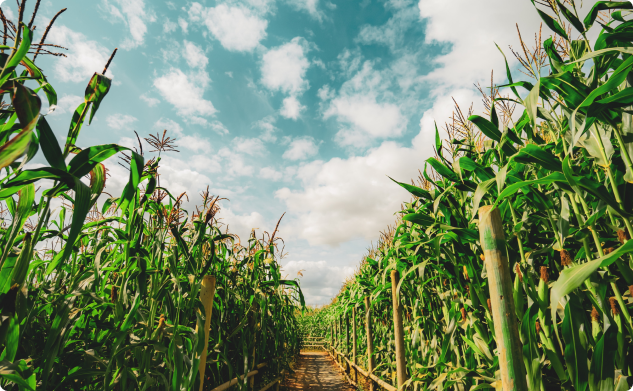
June 03, 2024
Most option traders understand how the premium is impacted by the direction of the underlying futures market. Because puts allow owners to protect lower prices, the value of the put increases as the market goes down. Conversely, because calls allow owners to protect higher prices, the value of calls increase as the market goes up.
This refers to the option’s “delta” or how much the premium will change for a given change in the underlying price of the futures contract. But there are other factors that determine how the option’s price will change including time and volatility. Understanding how changes in volatility impact the value of the option is an important part of determining when purchasing premium may be a good practice to protect against adverse price movements.
The implied volatility of an option is an objective measure of its cost. It helps translate the nominal premium into relative value across different strike prices of the underlying futures market. Because it is a measure of cost, it is important to understand historical volatility ranges and seasonality to evaluate when purchasing premium may benefit a hedger, particularly around times of the calendar year that are normally associated with increased uncertainty in the market.
As an example, early spring is a time of year when uncertainty begins to build for corn. The initial projected acreage base is released by NASS in the Prospective Plantings report in late March followed by weekly planting progress reports from USDA. Final acreage is then released in late June, at which point uncertainty is typically at its peak heading into pollination. Over the same span of time, implied volatility tends to seasonally increase in the options market.
Figure 1. December Corn Option Seasonal Volatility Chart

Leveraging Seasonal Volatility to Protect Adverse Price Changes:
Understanding that implied volatility seasonally increases through the spring, a corn buyer may benefit from owning options to protect against adverse changes in price during a period of growing uncertainty surrounding new crop value. Purchasing options entails cost and buyers pay for the premium in full at the time of purchase. In addition, they are exposed to time decay since the option erodes in value as it gets closer to its expiration. Changes in volatility however can either slow down or speed up this rate of decay. When volatility is increasing, it works against the time decay of the option by slowing it down.
If a commodity buyer purchases corn options ahead of an increase in the implied volatility of those options, it can offset the impact of time decay during the holding period, effectively giving the buyer a “free look” at how the market dynamics develop to determine whether they potentially need to protect themselves against higher prices. Let’s consider an example of a corn buyer purchasing call options earlier this spring in late March to protect against potential weather disruptions, lower acreage, or other factors that could possibly cause prices to rise and increase their input costs.
On March 28, NASS releases the Prospective Plantings report, and December 2024 corn futures are 15 cents higher on the day in response to a bullish acreage projection. The contract is trading at $4.77/bu., and the buyer decides to purchase the $5.00 call option to protect against the possibility of higher prices if the market continues to move up during April and May. The call options are trading at a premium of $0.33/bu. ($1,650/contract). Also on March 28, the implied volatility of at-the-money (ATM) December corn options is about 23% (Figures 2 and 3).
Figure 2. December 2024 Corn Futures Chart as of March 28:

Figure 3. December 2024 Corn Options Implied Volatility with 10-Year Range as of March 28:

From early April to mid-May, the corn market moves sideways to higher but by May 17, December futures are still trading at the same price of $4.77 as they were on March 28. At this point in time, the December $5.00 call options are also still trading at a premium of $0.33/bu. The difference though is now the implied volatility of those December call options are trading at around 26% as opposed to 23% in late March (Figures 4 and 5). This approximate 3% increase in implied volatility has completely offset the time decay in the option’s value during that period, essentially giving the buyer protection against higher prices over that 6-week window for zero cost (assuming they were to offset the call option at this point for the same premium they paid).
Figure 4. December 2024 Corn Futures Chart as of May 17:

Figure 5. December 2024 Corn Options Implied Volatility with 10-Year Range as of May 17:

Of course, it is important to note that implied volatility does not always behave seasonally and may decrease in certain years counter to its historical tendency. In other years though like 2023 (red line) the increase can be even more dramatic than the current year and possibly even more than offset or reverse the impact of time decay during the holding period. In other words, the call option would be worth more than what was paid even though time has elapsed, and the futures price is still the same.
Most commodity buyers are hesitant to setting or locking in a price using futures contracts until they have secured forward sales to protect a margin. Using options can provide a solution to this problem by not having a price commitment, although they entail cost which may be considered expensive. Understanding value though on when it may be advantageous to assume these costs can put buyers at a competitive advantage if they know how to leverage these tools to their benefit.
If you have questions or would like more information about option strategies for your operation, please contact CIH at 312.596.9338 or mail@cihedging.com.